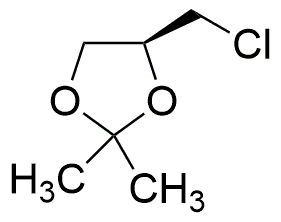(S)-4-Chloromethyl-2,2-dimethyl-1,3-dioxolane is widely utilized in research focused on:
- Synthesis of Pharmaceutical Intermediates: This compound serves as a key building block in the synthesis of various pharmaceuticals, enhancing the efficiency of drug development processes.
- Agrochemical Development: It is used in the formulation of agrochemicals, contributing to the creation of more effective pesticides and herbicides that improve crop yields.
- Polymer Chemistry: The compound can be incorporated into polymer matrices, providing unique properties such as improved thermal stability and chemical resistance, which are valuable in materials science.
- Research in Organocatalysis: It plays a role in organocatalytic reactions, offering a more environmentally friendly alternative to traditional catalysts, thus appealing to green chemistry initiatives.
- Flavor and Fragrance Industry: This chemical is also explored for its potential applications in the flavor and fragrance sector, where it can be used to create novel scents and flavors.
General Information
Properties
Safety and Regulations
Applications
(S)-4-Chloromethyl-2,2-dimethyl-1,3-dioxolane is widely utilized in research focused on:
- Synthesis of Pharmaceutical Intermediates: This compound serves as a key building block in the synthesis of various pharmaceuticals, enhancing the efficiency of drug development processes.
- Agrochemical Development: It is used in the formulation of agrochemicals, contributing to the creation of more effective pesticides and herbicides that improve crop yields.
- Polymer Chemistry: The compound can be incorporated into polymer matrices, providing unique properties such as improved thermal stability and chemical resistance, which are valuable in materials science.
- Research in Organocatalysis: It plays a role in organocatalytic reactions, offering a more environmentally friendly alternative to traditional catalysts, thus appealing to green chemistry initiatives.
- Flavor and Fragrance Industry: This chemical is also explored for its potential applications in the flavor and fragrance sector, where it can be used to create novel scents and flavors.
Documents
Safety Data Sheets (SDS)
The SDS provides comprehensive safety information on handling, storage, and disposal of the product.
Product Specification (PS)
The PS provides a comprehensive breakdown of the product’s properties, including chemical composition, physical state, purity, and storage requirements. It also details acceptable quality ranges and the product's intended applications.
Certificates of Analysis (COA)
Search for Certificates of Analysis (COA) by entering the products Lot Number. Lot and Batch Numbers can be found on a product’s label following the words ‘Lot’ or ‘Batch’.
*Catalog Number
*Lot Number
Certificates Of Origin (COO)
This COO confirms the country where the product was manufactured, and also details the materials and components used in it and whether it is derived from natural, synthetic, or other specific sources. This certificate may be required for customs, trade, and regulatory compliance.
*Catalog Number
*Lot Number
Safety Data Sheets (SDS)
The SDS provides comprehensive safety information on handling, storage, and disposal of the product.
DownloadProduct Specification (PS)
The PS provides a comprehensive breakdown of the product’s properties, including chemical composition, physical state, purity, and storage requirements. It also details acceptable quality ranges and the product's intended applications.
DownloadCertificates of Analysis (COA)
Search for Certificates of Analysis (COA) by entering the products Lot Number. Lot and Batch Numbers can be found on a product’s label following the words ‘Lot’ or ‘Batch’.
*Catalog Number
*Lot Number
Certificates Of Origin (COO)
This COO confirms the country where the product was manufactured, and also details the materials and components used in it and whether it is derived from natural, synthetic, or other specific sources. This certificate may be required for customs, trade, and regulatory compliance.


